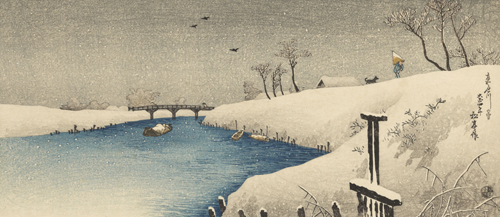
Your complimentary articles
You’ve read one of your four complimentary articles for this month.
You can read four articles free per month. To have complete access to the thousands of philosophy articles on this site, please
Articles
Young & Meaningful
Elise Beal notes a Japanese philosophy of finding pleasure in the small things, and matches it with an online trend.
“Our generation is so screwed.” I hear it everywhere on social media, and whispered in-between the lockers at the high school (I am a sixteen year old girl who thinks a lot, and notices more). As we read the headlines and succumb to the fearmongering, the endless nihilism stemming from the infinite trove of bad news that teenagers are exposed to online seems suffocating. I observe my friends and peers as they turn on their phones in the morning, faces blank despite the absurd amount of content we consume: social media, online articles, and various types of messages from both the loved and unloved, all read in the blink of an eye with a passive glance. It is impossible to deny the impact this technology has had on the younger generation’s minds. I even researched this article on my phone – reading studies while mindlessly following my sister through the airport, never appreciating the fact that an abundance of mental stimulation is available to me.

Snow on Ayase River Shōtei Takahashi 1915
With my generation of young adults, we are seeing how modern trends reflect a reformation in traditional philosophical thinking in response to societal change. And so, through quietly observing and spending long nights thinking and staring at the ceiling, I’ve come to notice patterns in how the young people around me perceive their existence, and how they have their own novel ideas about the world and their place in it.
Despite my own ramblings, I can assure readers that the average teenager is averse to thinking about philosophical concepts and wider issues of the universe, lest they have an existential crisis at sixteen. There is simply too much to think about, between school and sports and whatever else my friends choose to fill their days with. However, there is a simple way to discuss how this demographic copes with the existential undertones caused by the endless bad news.
In the midst of a technological revolution, our minds are flooded by an abundance of negative stimuli. Teenagers between thirteen and eighteen spend an average of eight and a half hours online, daily (The Common Sense Census: Media Use by Tweens and Teens, 2021), with the potential to be exposed to the worst kinds of content. It’s so prevalent, that society has coined a term for mindlessly scrolling past post after post of depressing content: doomscrolling. Teenagers now inhabit echo chambers of doubt and uncertainty, doomscrolling away, and this is a large part of what’s causing us to be increasingly nihilistic.
A Core of Hope
However, seemingly in response to this influx of bad news, teenagers are turning to new ways of coping with the suffocating pessimism of their social spheres. Interestingly, these coping strategies are spread by social media, the very mechanism responsible for fostering the negative viewpoints to begin with. (The juxtaposition of how social media perpetuates negativity and how it also offers coping mechanisms to combat it highlights the complex nature of social media.) These online trends share striking similarities with traditional Japanese philosophical concepts that were created to help one find one’s purpose in life.
Though social media has long been the bearer of bad news, many people have taken to creating under the hash-tag ‘Hopecore’ – a term first coined around March 2023, which continues to increase in use.
Hopecore builds on the many trending ‘core’ style/aesthetic ideas that have cycled through social media: other popular examples include ‘cottagecore’ (the romanticization of rural, ‘cottage’ life) and ‘kidcore’ (characterized by primary colors and feelings of nostalgia for a 90s childhood). These aesthetic types have been popularized online, and are used by the younger generation to express ourselves. The main difference between hopecore and other online aesthetics is that hopecore seems to be the manifestation of an optimistic philosophy that’s been created in response to the mounting tension and negativity online.
‘Hopecore’, as its name suggests, is an aesthetic focusing on hope. Often while scrolling through the hopecore hashtag, one will find simplistic pictures, say, of rabbits asleep in fields, accompanied by inspirational quotes like “Lovely things come and go, but they come” scrawled atop the image. “Slow down. Appreciate the little things” now appears on a glowing screen amidst the mess of online content. Following this advice, one might pause and take a break from the endless scrolling…
The intention of such posts is to get the audience to appreciate the little things, to pause and feel the warm feeling that rabbits in fields and words of affirmation give us. Hopecore centers on humanity and positivity, often focusing on everyday interactions, and on romanticizing the little things: the way sunlight filters through the window, or the smell of coffee on a rainy day, for instance.
Small & Beautiful
Interestingly, hopecore shares a striking resemblance to the Japanese philosophical concept of ikigai.
To understand their similarities, first, we must debunk some misconceptions about what ikigai is and why it was created. Translating roughly to ‘a reason to live’, ikigai has its roots in Buddhist philosophy and traditional Japanese values.
At its core, it’s simple, and if you asked any older person in my Japanese American community what it meant to them, you would get a straightforward response: it’s seeking joy in the little things. That is to say, ikigai is somewhat ambiguous, but quite one-dimensional in comparison with other (Western) philosophical ideals. More expansively, ikigai implies that the meaning of life can be found through purpose, and that purpose can be found by starting small.
Western interpretations of ikigai are very different. In Western media, ikigai is often depicted through a Venn diagram, as an uncomplicated way of finding happiness and purpose in life, whereby if you find something to focus on that satisfies a whole range of needs (beauty, emotional resonance, etc), you will find meaning, and thus purpose.
The question why the concept has been misinterpreted so grievously is a complicated one; but to answer it one must take differences between East Asian and Western cultures into account. Japan, at heart a collectivist society, places its highest values in the community, whereas Western societies such as the United States, being individualist, place their highest value on individualism and individually ‘getting ahead’. This is why in Western culture ikigai is often depicted as an endpoint – an overarching goal of finding everyday beauty that, once reached, will reward the person with a concrete sense of purpose. Yet by comparing the differences between the two cultures’ interpretations of ikigai, we can better understand both the concept and the cultures. I think the pressure to succeed has caused much of the West to interpret ikigai as a destination, something to be found, rather than the concept that it was originally: finding small joys. Basically, ‘finding’ ikigai isn’t something grand and monumental, but rather consists of many, many little moments that each make you appreciate life. The idea is that it is from this appreciation that purpose is born. It is from this latter, traditional definition that we can draw similarities with hopecore. In essence, both ikigai and hopecore are simple: The little things make life worth living.
Understanding hopecore’s similarities with ikigai, and recognizing its birth from a place of psychological instability, gives us a unique perspective on the younger generation and how we deal with complex topics. Being exposed to so much online content with negative existential undercurrents has changed the way my peers and I perceive life, but it’s being combated with yet more online content, now utilized in a positive way, in the form of hopecore and other trends, to offer purpose and structure at a time when it’s direly needed. Sparked by the nihilism caused by echo chambers of bad news, hopecore is a stand against the bad in the world, and is one of the younger generation’s unique ways of countering the nihilism to which we’re so often exposed.
A Last Little Bit of Hope
However much society and culture changes with time, I am confident in one thing: humanity’s unyielding hope. There has always been hope, manifesting in billions of ways among billions of people: by drawing horses and other animals on cave walls, in the hope that the day’s hunt would be bountiful; burying a king beneath a vast pyramid of stone in the hope that he may go to a place of eternal happiness; putting a post on the internet in the hope that others may stumble upon it and begin to dream again; and, creating a philosophy to appreciate the mundane in the hope that this will grant you meaning.
With that, I leave you with, not the ending, but the middle of a million peoples’ story. Only when I’m old and gray and looking back at my teenage years, will I be able to draw a semblance of a concrete conclusion about how humanity’s philosophies have evolved with technology. Until then, I will continue to scroll on social media, eyes bleary and constantly looking for something to satisfy my addiction. And occasionally, in between the clips of cute dogs and news stories about the latest atrocity, I will read a line or a poem that reminds me to pause. To appreciate the small joys. And maybe, with that, I will find a tiny bit more meaning in my life.
© Elise Beal 2025
Elise Mayumi Beal is a high school student based in San Jose, California.









